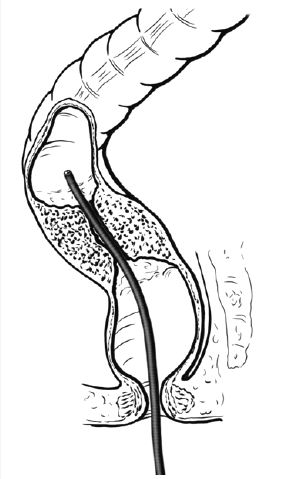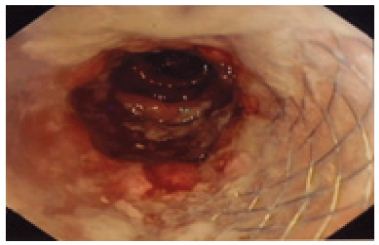- Submissions

Full Text
Gastroenterology Medicine & Research
Improved Results for Endoscopic Colorectal Stenting with Establishment of a Common Endoscopic Centre for Gastroenterologists and Surgeons
Antonietta lamazza, Enrico Fiori and Antonio V Sterpetti*
*Corresponding author: Antonio V Sterpetti, Istituto pietro valdoni, University of Rome Sapienza, Policlinico Umberto I- Viale del Policlinico 00167 Rome, Italy
Submission: August 02, 2017; Published: August 18, 2017

ISSN 2637-7632
Volume1 Issue1
Opinion
Endoscopic stenting for malignant colorectal obstruction has become a common therapeutic advancement in clinical practice [1-5]. We report our experience with 200 patients in 18 years. All procedures were performed in a close collaboration between surgeons and gastroenterologists. All procedures were approved by the Department Council and all patients gave and signed informed consent.
There was no case of postoperative mortality or major morbidity. Technical success was obtained in 95% of the patients. In 8 patients it was not possible to pass the guidewire through the obstruction, due to sharp angulation of the obstruction. After consulting a surgeon, the procedure was not continued. Surgical colorectal resection appeared a more appropriate procedure. Clinical success was obtained in 92% of the patients. In 4 patients with ascites and peritoneal implants, despite technical success of stent placement, symptoms of obstruction persisted. In another 10 patients, with ascites and stage IV colorectal cancer, placement of a stent was not considered appropriate (Figure 1A & 1B).
Figure 1A: Use of thin pediatric nasogastroscope to pass the colorectal obstruction.

Figure 1B:Use of thin pediatric nasogastroscope to pass the colorectal obstruction.

During the same time period, 35 patients with stage IV colorectal cancer and 25 patients with acute obstruction, underwent surgical colorectal resection. After consultation between surgeons and gastroenterologists, the option of surgery was considered the safest and best option.The initial therapeutic option was changed in 60 patients. In thirty five patients, initially considered candidate for stenting, surgery was considered a more appropriate choice. Twenty five patients, initially considered candidates for surgery, had endoscopic stenting (Figure 2).
Figure 2:: Colorectal stent in a patient with bleeding, obstructing colorectal cancer.

SEMS placement represents an important tool to treat patients with obstructing colorectal cancer and complications after colorectal resection. In patients with malignant colorectal obstruction, the therapeutic options , including endoscopic placement of a stent, should be based on a careful analysis of the different risk factors. In this scenario, a close collaboration among specialists is essential and brings to better results.
References
- Lamazza A, Fiori E, Schillaci A, Sterpetti AV, Lezoche E (2014) Treatment of anastomosis stenosis and leakage after colorectal resection with selfexpanadable metal stents. Am J Surg 208(3): 465-469.
- Lamazza A, Fiori E, Schillaci A, Sterpetti AV (2013) A new technique for self-expandable metal stent placement in patients with colorectal obstruction. Surg Endosc 27(3): 1045-1048.
- Lamazza A, Sterpetti AV, De Cesare A, Schillaci A, Antoniozzi A, et al. (2015) Endoscopic placement of self-expanding stents in patients with symptomatic leakage after colorectal resection for cancer: Long term results. Endoscopy 47(3): 270-272.
- Lamazza A, De ME, Fiori E, Sterpetti AV, Scoglio D, et al. (2013) Self expanding metal stents for treatment of anastomotic complication after colorectal resection. Endoscopy 45(6): 493-495.
- Lamazza A, Fiori E, Sterpetti AV, Schillaci A, Scoglio D, et al. (2014) Self expandanble metal stents in the treatmjent of benign anastomotic stricture after rectal resection for cancer. Colorectal Dis 16(4): 150-153.
© 2017 Antonietta lamazza, et al. This is an open access article distributed under the terms of the Creative Commons Attribution License , which permits unrestricted use, distribution, and build upon your work non-commercially.
 a Creative Commons Attribution 4.0 International License. Based on a work at www.crimsonpublishers.com.
Best viewed in
a Creative Commons Attribution 4.0 International License. Based on a work at www.crimsonpublishers.com.
Best viewed in 







.jpg)






























 Editorial Board Registrations
Editorial Board Registrations Submit your Article
Submit your Article Refer a Friend
Refer a Friend Advertise With Us
Advertise With Us
.jpg)






.jpg)














.bmp)
.jpg)
.png)
.jpg)










.jpg)






.png)

.png)



.png)






